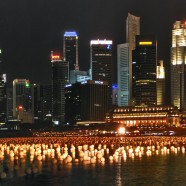The Future Of LED Lighting: A Brave New World
What’s the biggest difference between LEDs and other forms of lighting systems? Is it that they’re 85% more efficient than incandescent bulbs? Or that they last thousands of hours longer than CFLs? While there are obvious benefits, according to Fast Company, the most revolutionary component of LEDs is likely to be their ability to recognize digital signals. For the first time, our lighting systems are going from analog to digital.
No longer do lights just turn “off” or “on.” Now they can be “tuned” to emit any color of the rainbow, or change temperature and brightness, all from the touch of a finger on your smartphone app.
We’re now staring at the future of LED lighting, and it’s a beautiful, brave new world.
Since 2007, the U.S. has been effectively phasing out inefficient incandescent lighting through federal regulations enacted in the Energy Independence and Security Act. After starting out with an effective ban on 100-watt incandescent bulbs in 2012, followed by 75-watt bulbs in 2013 and 60- and 40-watt in 2014, LEDs have been the industry favorite as a replacement for Edison’s monumental invention over a century ago.
One of the first reasons that LEDs took off instead of efficient but sterile CFLs is that they contain solid-state lighting (SSL) semiconductors.
It was just twenty years ago Nichia’s Shuji Nakamura invented the blue LED in Japan. By covering the blue light in phosphorous coating, the industry was soon able to introduce a white LED light onto the market. While the first generation of LED lighting failed to outperform traditional lighting sources in performance and pricing, the predictable improvement curve of SSL has led prices to fall dramatically as product research and investment has skyrocketed. By 2013, Cree had released a LED bulb that looked and felt like a 60-watt incandescent, priced at under $14.
By 2014, the LED lighting market is estimated at $17.4 billion and is predicted for rapid growth through 2020.
The current rise can be explained mostly by LED technology’s superior durability, efficiency and performance in comparison to other lighting technologies. Further, the emergence of home automation and the “Internet of Things” will only serve to catapult LEDs to deeper and deeper market penetration rates.
Here are benefits that digital networks and intelligent home automation systems hold for the future of LED lighting and human well-being.
Health Benefits:
“You have to start thinking of light as a drug,” said Terry K. McGowan, the director of engineering for the American Lighting Association, in an interview with nytimes.com. That means that we have to start recognizing the impact lighting has on our mental and emotional states. As artists have known for a long time, color affects our moods and can elicit emotional and physiological responses. For example, blue wavelengths in light — which LEDs are rich in due to their reliance on blue lights — have been shown to help us stay awake.
Furthermore, LED lights can be programmed to follow the natural light rhythms of sunlight. This will increase human well-being by maximizing the efficiency of our circadian rhythms to indoor lighting, increasing focus, energy and fighting insomnia and depression disorders. Installed at work, automated LEDs will be able to increase worker productivity. Installed in the bedroom, automated LEDs will be able to help us fall asleep and wake up on time.
Not only that, but LEDs are an amazing tool for indoor gardening, which help people, even those living in poor growing climates, to produce their own organic food and plants.
Energy Efficiency Benefits:
LEDs are already 80% more efficient that incandescents and a good 20% to 30% more efficient than most CFL options. But the efficiency of the technology doesn’t end at the individual diode. LEDs are much better than CFLs for home automation systems due to the advanced control options and rapid response switching and dimming.
Using home automation systems, LED lights can be programmed to turn off or dim down when rooms are not in use. This will further increase the efficiency gains by removing human error and letting computer efficiency bring down the bill. As another option, outdoor lights can be programmed to the internet to track the sunrise each day and turn off at the appropriate time. Once installed, these systems would run themselves, letting the computers take care of turning lights on and off, letting humans focus on other more exciting aspects of life.
Synchronizing Daily Life:
LEDs are set to become a critical component in the much heralded Internet of Things. Not only will LEDs be connected to the internet, but many are looking into options that will allow LEDs to connect the internet to you.
Li Fi technology is similar to wi fi, except instead of using radio waves, it uses flickering LED lights to transfer data signals. This means the lighting in your house could be used to connect other appliances such as toasters, baths and computers to the internet and home automation systems. As the internet has revolutionized our lives over the past twenty years, in the next five to ten, many people are saying the Internet of Things will be the next major step.
But whatever happens in the future of LED lighting, we’re excited to be a part of it. If you have any questions about LEDs, and specifically LED strip lighting, remotes, and dimmers, please stop by our website at flexfireleds.com or give us a call at 1-844-FLEXFIRE to talk with one of our design specialists today.











